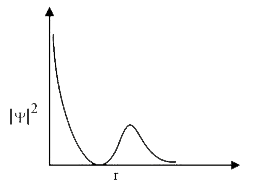The total magnetic quantum numbers for d-orbitals is given by
2
0,±1,±2
0,1,2
5
The correct Answer is:B
To find the total magnetic quantum numbers for d-orbitals, we can follow these steps:
Step 1: Identify the Quantum Numbers
There are four quantum numbers that describe the state of an electron in an atom:
1. Principal quantum number (n)
2. Azimuthal (or angular momentum) quantum number (l)
3. Magnetic quantum number (m)
4. Spin quantum number (s)
Step 2: Determine the Azimuthal Quantum Number for d-orbitals
For d-orbitals, the azimuthal quantum number l is equal to 2. This is because:
- l=0 corresponds to s-orbitals
- l=1 corresponds to p-orbitals
- l=2 corresponds to d-orbitals
- l=3 corresponds to f-orbitals
Step 3: Calculate the Magnetic Quantum Numbers
The magnetic quantum number m can take values from −l to +l. Therefore, for l=2:
- The possible values of m are:
m=−2,−1,0,+1,+2
Step 4: Count the Total Magnetic Quantum Numbers
The total number of distinct magnetic quantum numbers for d-orbitals is the count of the values obtained in Step 3:
- The values are: −2,−1,0,+1,+2
- This gives us a total of 5 magnetic quantum numbers.
Conclusion
Thus, the total magnetic quantum numbers for d-orbitals is 5.
---
There are four quantum numbers that describe the state of an electron in an atom:
1. Principal quantum number (n)
2. Azimuthal (or angular momentum) quantum number (l)
3. Magnetic quantum number (m)
4. Spin quantum number (s)
For d-orbitals, the azimuthal quantum number l is equal to 2. This is because:
- l=0 corresponds to s-orbitals
- l=1 corresponds to p-orbitals
- l=2 corresponds to d-orbitals
- l=3 corresponds to f-orbitals
The magnetic quantum number m can take values from −l to +l. Therefore, for l=2:
- The possible values of m are:
m=−2,−1,0,+1,+2
The total number of distinct magnetic quantum numbers for d-orbitals is the count of the values obtained in Step 3:
- The values are: −2,−1,0,+1,+2
- This gives us a total of 5 magnetic quantum numbers.
Thus, the total magnetic quantum numbers for d-orbitals is 5.
Topper's Solved these Questions
- ATOMIC STRUCTUREBook:ERRORLESS Chapter:ATOMIC STRUCTUREExercise:CRITICAL THINKING
Explore 22 Videos
- ATOMIC STRUCTUREBook:ERRORLESS Chapter:ATOMIC STRUCTUREExercise:JEE SECTION
Explore 75 Videos
- ATOMIC STRUCTUREBook:ERRORLESS Chapter:ATOMIC STRUCTUREExercise:Uncertainty principle and Schrodinger wave equation
Explore 22 Videos
- SURFACE CHEMISTRYBook:ERRORLESS Chapter:SURFACE CHEMISTRYExercise:JEE Section (Matching Column)
Explore 2 Videos
Similar Questions
Knowledge Check
The magnetic quantum number specifies.
Asize of orbitalsBshape of orbitalsCorientation of orbitalsDnuclear stabilityThe possible values of magnetic quantum number for p-orbital are
A0B−1,0,+1C−2,−1,0,+1,+2D−3,−2,−1,0,+1,+2,+3For the azimuthal quantum number 'I' the total number of magnetic quantum numbers is given by
Al=(m+1)2Bl=m−12Cl=2m+12Dl=2m−12
What is the toal number of orbitals associated with the principal quantum number n=3 ?
Hint : The total number of orbitals in a shell is given by formula =n2 ?
View SolutionFor the azimuthal quantum number 'I' the total number of magnetic quantum numbers is given by
View SolutionMagnetic quantum number specifies:
View SolutionThe values of quantum numbers for 2p orbitals are :
View SolutionThe magnetic quantum is a number related to:
View Solution
